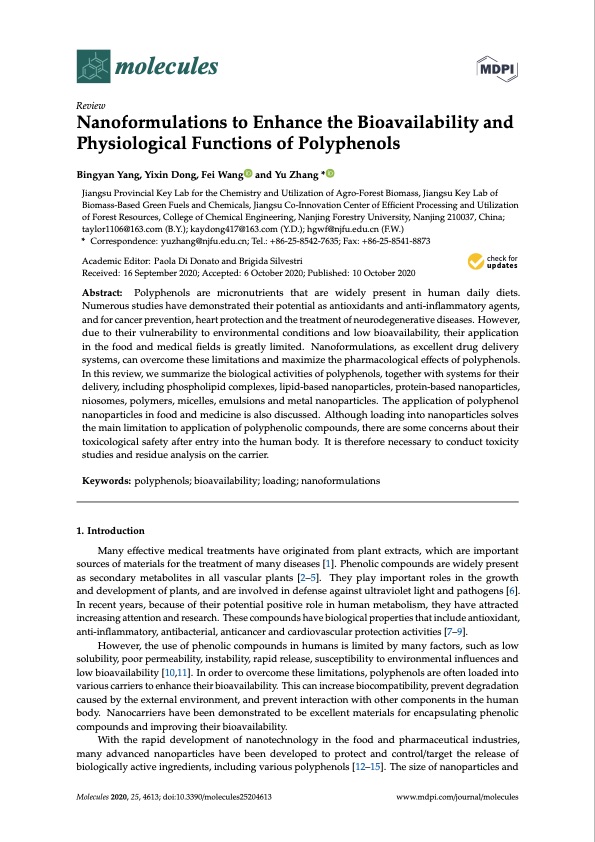
PDF Publication Title:
Text from PDF Page: 001
molecules Review Nanoformulations to Enhance the Bioavailability and Physiological Functions of Polyphenols Bingyan Yang, Yixin Dong, Fei Wang and Yu Zhang * Jiangsu Provincial Key Lab for the Chemistry and Utilization of Agro-Forest Biomass, Jiangsu Key Lab of Biomass-Based Green Fuels and Chemicals, Jiangsu Co-Innovation Center of Efficient Processing and Utilization of Forest Resources, College of Chemical Engineering, Nanjing Forestry University, Nanjing 210037, China; taylor1106@163.com (B.Y.); kaydong417@163.com (Y.D.); hgwf@njfu.edu.cn (F.W.) * Correspondence: yuzhang@njfu.edu.cn; Tel.: +86-25-8542-7635; Fax: +86-25-8541-8873 Academic Editor: Paola Di Donato and Brigida Silvestri Received: 16 September 2020; Accepted: 6 October 2020; Published: 10 October 2020 Abstract: Polyphenols are micronutrients that are widely present in human daily diets. Numerous studies have demonstrated their potential as antioxidants and anti-inflammatory agents, and for cancer prevention, heart protection and the treatment of neurodegenerative diseases. However, due to their vulnerability to environmental conditions and low bioavailability, their application in the food and medical fields is greatly limited. Nanoformulations, as excellent drug delivery systems, can overcome these limitations and maximize the pharmacological effects of polyphenols. In this review, we summarize the biological activities of polyphenols, together with systems for their delivery, including phospholipid complexes, lipid-based nanoparticles, protein-based nanoparticles, niosomes, polymers, micelles, emulsions and metal nanoparticles. The application of polyphenol nanoparticles in food and medicine is also discussed. Although loading into nanoparticles solves the main limitation to application of polyphenolic compounds, there are some concerns about their toxicological safety after entry into the human body. It is therefore necessary to conduct toxicity studies and residue analysis on the carrier. Keywords: polyphenols; bioavailability; loading; nanoformulations 1. Introduction Many effective medical treatments have originated from plant extracts, which are important sources of materials for the treatment of many diseases [1]. Phenolic compounds are widely present as secondary metabolites in all vascular plants [2–5]. They play important roles in the growth and development of plants, and are involved in defense against ultraviolet light and pathogens [6]. In recent years, because of their potential positive role in human metabolism, they have attracted increasing attention and research. These compounds have biological properties that include antioxidant, anti-inflammatory, antibacterial, anticancer and cardiovascular protection activities [7–9]. However, the use of phenolic compounds in humans is limited by many factors, such as low solubility, poor permeability, instability, rapid release, susceptibility to environmental influences and low bioavailability [10,11]. In order to overcome these limitations, polyphenols are often loaded into various carriers to enhance their bioavailability. This can increase biocompatibility, prevent degradation caused by the external environment, and prevent interaction with other components in the human body. Nanocarriers have been demonstrated to be excellent materials for encapsulating phenolic compounds and improving their bioavailability. With the rapid development of nanotechnology in the food and pharmaceutical industries, many advanced nanoparticles have been developed to protect and control/target the release of biologically active ingredients, including various polyphenols [12–15]. The size of nanoparticles and Molecules 2020, 25, 4613; doi:10.3390/molecules25204613 www.mdpi.com/journal/moleculesPDF Image | Nanoformulations to Enhance the Bioavailability and Physiological Functions of Polyphenols

PDF Search Title:
Nanoformulations to Enhance the Bioavailability and Physiological Functions of PolyphenolsOriginal File Name Searched:
molecules-25-04613-v2.pdfDIY PDF Search: Google It | Yahoo | Bing
Turbine and System Plans CAD CAM: Special for this month, any plans are $10,000 for complete Cad/Cam blueprints. License is for one build. Try before you buy a production license. More Info
Waste Heat Power Technology: Organic Rankine Cycle uses waste heat to make electricity, shaft horsepower and cooling. More Info
All Turbine and System Products: Infinity Turbine ORD systems, turbine generator sets, build plans and more to use your waste heat from 30C to 100C. More Info
CO2 Phase Change Demonstrator: CO2 goes supercritical at 30 C. This is a experimental platform which you can use to demonstrate phase change with low heat. Includes integration area for small CO2 turbine, static generator, and more. This can also be used for a GTL Gas to Liquids experimental platform. More Info
Introducing the Infinity Turbine Products Infinity Turbine develops and builds systems for making power from waste heat. It also is working on innovative strategies for storing, making, and deploying energy. More Info
Need Strategy? Use our Consulting and analyst services Infinity Turbine LLC is pleased to announce its consulting and analyst services. We have worked in the renewable energy industry as a researcher, developing sales and markets, along with may inventions and innovations. More Info
Made in USA with Global Energy Millennial Web Engine These pages were made with the Global Energy Web PDF Engine using Filemaker (Claris) software.
Infinity Turbine Developing Spinning Disc Reactor SDR or Spinning Disc Reactors reduce processing time for liquid production of Silver Nanoparticles.
| CONTACT TEL: 608-238-6001 Email: greg@infinityturbine.com | RSS | AMP |